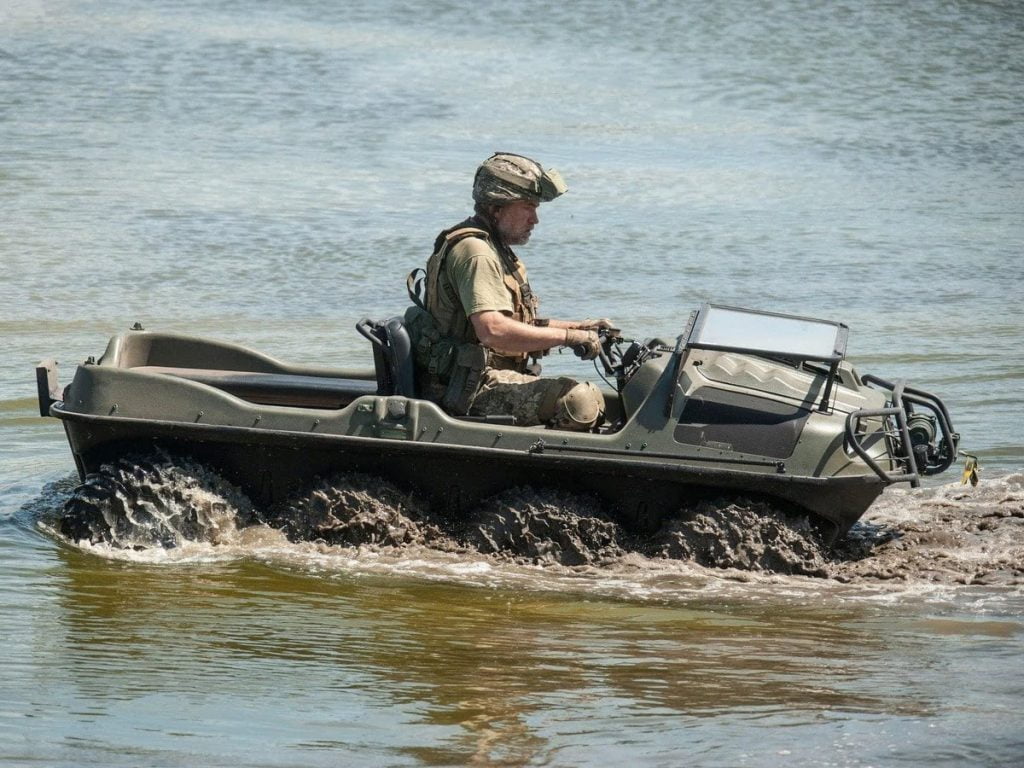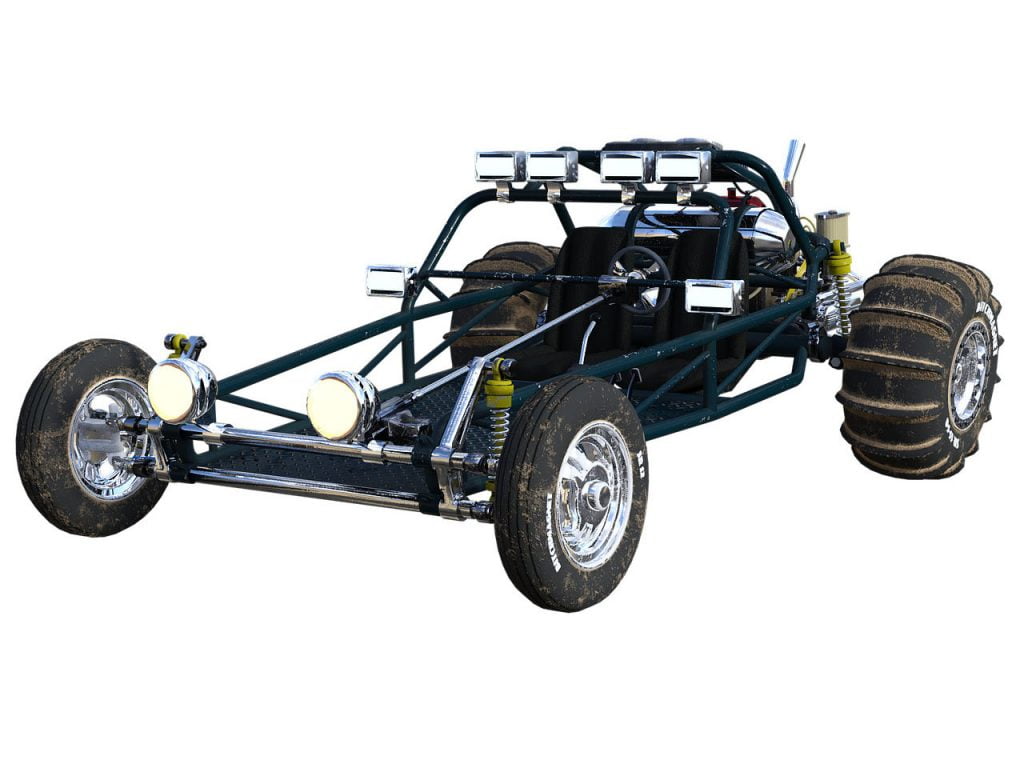In the world of off-road vehicles, it’s common for beginners to label any rugged, off-road capable vehicle as an ATV (All-Terrain Vehicle).
However, once you delve deeper into this realm, you’ll find a variety of vehicles, each tailored to meet distinct needs and purposes, which differ from the general functionality of a standard ATV.
In this post, we’ll go through the most common vehicle types that may appear similar but don’t quite fit within the traditional definition of what makes an ATV.
What Is Considered an ATV – And What Is Not?
Before looking at the alternatives, we need to understand what is considered an ATV and what is not.
The term ATV is short for All Terran Vehicle, and therein lies much confusion. Although a vehicle may be capable of riding off-road, this doesn’t necessarily make it an all-terrain vehicle.
While there is no worldwide official definition of the term ATV, the industry often refers to the ANSI (American National Standards Institute) defining an ATV as a “motorized off-highway vehicle designed to travel on four low-pressure or non-pneumatic tires, having a seat designed to be straddled by the operator and handlebars for steering control.”
Dissecting this definition gives us a clearer perception of what it takes for a vehicle to be regarded as an ATV and which vehicles are not.
- Motorized: To be regarded as an ATV, a vehicle must use a motorized engine to provide motion. This rules out any man-powered vehicle, such as bicycles.
Any vehicle with a combustion engine that uses any fossil fuel such as gasoline or diesel or has an electric motor entirely powered by electricity is considered motorized.
- Off-highway: You cannot ride an ATV legally on the road in most states and countries. While some exceptions allow ATVs on more minor roads, you typically cannot ride on the highway.
ATVs are designed for optimal off-road performance at low to medium speeds and are less stable at higher speeds. This part of the definition rules out vehicles such as Jeeps, which are designed for off- and on-road use.
- Four low-pressure or non-pneumatic tires: ATVs typically have four tires. It cannot have only two, like a motorcycle. Early ATVs came with three tires, two at the back and one in the front. However, three-wheeled ATVs are no longer allowed due to an increased risk of tipping.
Some current ATV models come with as many as six tires, but these are considered specialized models and are much less common than four-wheeled ATVs. Note that the vehicle doesn’t need to have four-wheel-drive (4X4) to be considered an ATV. 4×2 is common in racing quads and youth models.
In addition, the tires should be low-pressure for better traction and flotation in slippery or soft off-road conditions. Non-pneumatic tires (not inflated with air) are not as common but are sometimes used in conditions that require high puncture resistance, such as military operations.
- A seat designed to be straddled by the operator: On a straddled seat, the rider sits on top with one leg on either side, similar to a motorcycle or a horse saddle. This design allows the rider to move freely from side to side and back to forth while riding off-road but offers fewer safety features, such as a seatbelt.
This part of the definition leaves out any vehicle with a bucket-style seat, as you find on cars and UTVs. On ATVs designed to bring a passenger, the passenger is seated right behind and in line with the rider.
- Handlebars for steering: An ATV uses handlebars like those on motorcycles and snowmobiles. If a vehicle has a steering wheel like a car, it is not considered an ATV.

One of the main characteristic features that set an ATV apart from other similar off-road and lightweight utility vehicles is its design for a wide range of uses and its capability to ride in just about any terrain.
Whether it’s recreational trail riding, crossing bottomless muddy grounds, technical off-road riding such as rock-crawling, dune bashing in the desert, farm and utility work, or rescue operations in remote locations, an ATV has got you covered.
Within the ATV definition outlined above, there are several different types and styles of ATVs, such as sports, recreational, utility, youth, and more. Check out this post to learn more about various ATV types.
Other terms commonly used when referring to an ATV are four-wheeler and quad (or quad bike).
When comparing an ATV to other off-road vehicles, the expression “Jack of all trades, master of none” comes to mind. However, versatility is not always what you need.
Depending on your lifestyle and specific riding applications, other more specialized vehicle types may suit you better. Let’s look at what they are.
UTV (Utility Terrain Vehicle) and SxS (side-by-side)

UTVs, or Utility Terrain Vehicles, occupy a unique space in the off-road world, positioned between ATVs and larger off-road trucks like Jeeps.
They are frequently mistaken for ATVs, but they offer distinct features. UTVs are also known as SxS (Side-by-side), highlighting their design allowing passengers to sit side-by-side.
UTV, SxS, and side-by-side are interchangeable terms that both refer to a vehicle type with the following main characteristic design features:
- Has a longer wheelbase, wider track width, and lower center of gravity than an ATV. UTVs are designed more toward speed and stability than extreme off-road capabilities and maneuverability in tight spots like ATVs.
- Uses a non-straddled seating position. On a UTV or SxS, you do not sit in a straddled seating position. Instead, you’re seated with both legs placed in front of you.
Sport-oriented models typically use bucket-style seats to keep riders and passengers in place at higher speeds. In contrast, utility-oriented models usually use a bench-style seat that is easy to get in and out of.
On two-seated UTVs, the seats are placed on the side of each other, thereby the nickname side-by-side. On four-seated UTVs, another row with two seats is added behind the driver and front passenger, just like on a car.
- Comes with a roll cage. The stationary seating position allows the designers to include a protective roll-cage that helps protect the driver and passengers in the event of an accident or tipping.
- Has a steering wheel and pedals. UTVs use a steering wheel for steering rather than handlebars. And for throttle operation and braking, they use pedals rather than levers like on ATVs.
Related: This Is Why ATVs Don’t Have Seatbelts, but UTVs Do
Like ATVs, UTVs come in various types designed for youth riders, racing, recreational riding, or utility work.
XTV (Xtreme Terrain Vehicle)

While ATVs are referred to as “all-terrain vehicles,” there are limits to how soft and wet ground they can handle before sinking in. Some people solve this by installing oversized mud tires, lift kits, and snorkels on their ATVs, immersing in an activity known as mudding.
However, this setup is more geared towards fun and play than work or transport.
If you need a lightweight, agile utility vehicle that excels on very soft terrain and wetlands, consider a 6X6 or 8X8 amphibious vehicle, also known as an XTV. Argo is the top manufacturer in this category, and they have been leaders in the field since introducing these vehicles in the 1960s.
These vehicles are engineered to avoid sinking under extreme conditions. Their waterproof hull enables them to float on water. While their amphibious nature doesn’t make them substitutes for boats, they can cross slow-moving streams and small ponds when necessary.
In these vehicles, steering is achieved not by turning the wheels, which remain parallel at all times, but through individual hand levers that control the left and right lines of wheels separately. This method allows the vehicle to spin similarly to a tracked vehicle. Additionally, this wheel configuration permits the installation of tracks.
Note that this design has a couple of drawbacks compared to a conventional ATV. As there is no suspension, you can expect a more bumpy ride. The lack of suspension and the steering design prevent you from traveling safely at higher speeds, making them less ideal for recreational trail riding.
Dune-Buggy

Dune buggies are modified or purposely built to operate in the desert dunes. The first dune buggies were based on a VW beetle chassis, but today, most dune buggies are purpose-built from the ground up. Here are some key design features that separate dune buggies from ATVs:
- The design resembles UTVs more than ATVs, with steering wheels and pedals for controls, a protective roll cage, and sit-in seats. UTVs specifically designed for dune-bashing are available and are becoming increasingly popular.
- The RWD and rear engine layout provide better traction in the sand.
- The rear wheels are typically paddle-style sand tires, while the front wheels are designed only for steering.
- Long-travel suspension allows for long jumps and high speed.

Compact Tractor

A large selection of farm equipment and accessories for ATVs is on the market. These implements are intended for small-scale farming and homestead owners. For those looking for a vehicle for anything from trail riding, hunting, and firewood collection but only a limited scope of heavy farming tasks such as tillage, the versatility of an ATV may offer the ideal solution.
But, before you sign the deal on a new ATV, it’s a good idea to consider their limitations, primarily regarding some of the heavier farming tasks.
- Due to their relatively lightweight construction, they offer limited traction for heavy pulling, such as plowing.
- The gearbox on an ATV is designed more toward higher speeds. Heavy pulling at slow speeds may cause issues such as premature drive belt wear.
- The suspension on ATVs is designed to handle rough terrain at moderate to higher speeds. This requires softer and longer travel suspension travel with limited load capacity. While lifting attachments such as front loaders and rear three-point hitch are available, the soft suspension limits how much you can lift or carry.
- ATVs don’t come with a built-in PTO shaft or hydraulic pump. This means that you need a separate petrol engine and possibly a hydraulic pump unit to power attachments such as a snow blower, flail mower, or forestry trailer with a hydraulic crane.
So, if utility and farming tasks on your homestead are your primary objective rather than trail riding or passenger transport, a compact tractor could be the better option.
Compact tractors are small-scale tractors that offer much of the same functionality as a full-scale tractor but at a reduced capacity. They can’t lift or pull as much but can provide adequate power for the smallest tasks.
These machines typically provide more pulling and lifting power than ATVs but operate at a slower speed. Their solid axles can handle higher loads, and their transmissions are geared towards slow speeds only. Compact tractors are available with a PTO shaft and built-in hydraulic outlets.
Golf Kart

Gold karts are designed for passenger transport and carrying golfing equipment around a golf court. They work best on smooth surfaces and offer only minimal off-road capability.
While taking a golf kart off-road may seem like a good idea, please don’t. Unless you own a gold court or you’re looking for a comfy vehicle only to cruise the pathways around your mansion, an ATV is probably a better option.
Go-Kart

Go-karts are small, motorized vehicles designed for close-circuit racing. They offer high speed and excellent handling on smooth paved surfaces, but due to the lack of suspension and racing slick tires, they are useless off-road and even on gravel roads.
Cross Kart

Like go-karts, cross-karts are primarily intended for closed-circuit racing but are designed to handle more uneven tracks. They typically have a protective roll cage, long-travel suspension, and more aggressively treaded tires.
With the steering wheel, pedal operation, and sit-in seat design, cross-karts are more similar to UTVs than ATVs.
Rock-Crawler
A rock crawler is a motorized four-wheel-drive vehicle designed explicitly for slow-speed technical off-road riding, typically on rocky and uneven grounds.
Some riders modify their jeep or UTV to improve their rock-crawling capabilities. The most dedicated enthusiasts, however, design and build extreme rock crawler trucks from the ground up.
Key design features include a low center of gravity, transmission geared for slow speeds, long travel suspension, grippy tires, and a roll cage with seat and seatbelts to protect the rider if/when the vehicle flips.
ATVs are not well suited for extreme rock crawling due to their relatively high center of gravity, narrow track width, short wheelbase, and lack of a protective roll cage.
RTV – Rugged Terrain Vehicle

RTV (Rugged Terrain Vehicle) is not a general category of off-road vehicles. Instead, it is a specific term Kubota uses to describe their range of utility UTVs (Utility Terrain Vehicles). This designation highlights the durability and off-road capabilities of Kubota’s UTV lineup.
Related: What is an RTV Vehicle? ATV vs. RTV vs. UTV Explained
Variations in ATV Definitions Across Different States
As if navigating the various terms used for different vehicle types in the off-road world isn’t challenging enough, some states have stated state-specific terms and definitions of an ATV.
For instance, in Oregon law, the term All-Terrain Vehicle includes motorcycles, 3-wheelers, quads, side-by-sides, sand rails, trucks, and SUVs. The term is divided into four different ATV classes:
- Class 1 ATV: quads (ATVs according to the ANSI definition) and 3-wheelers
- Class 2 ATV: 4x4s and sand rails (dune buggies)
- Class 3 ATV: motorcycles
- Class 4 ATV: side-by-sides (UTV, SxS)
